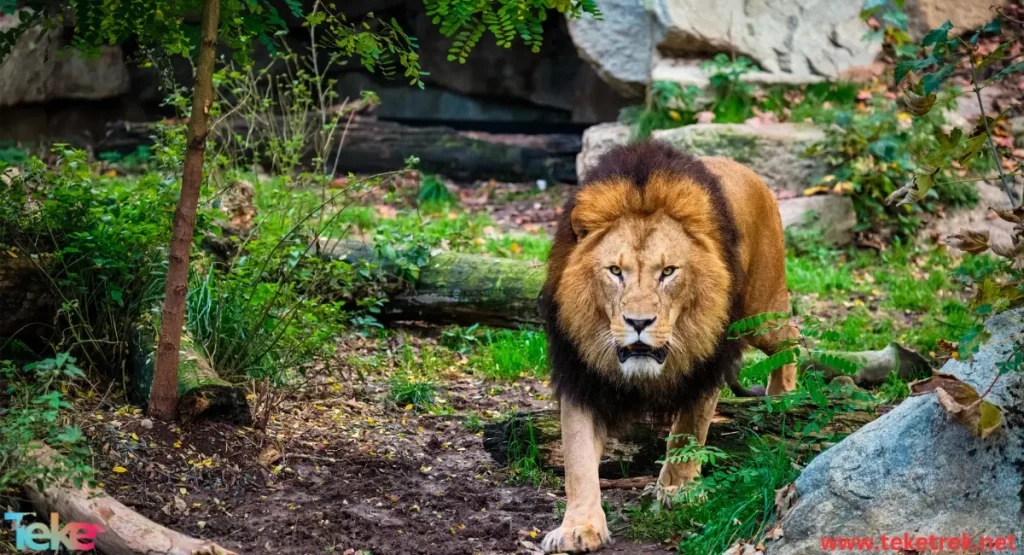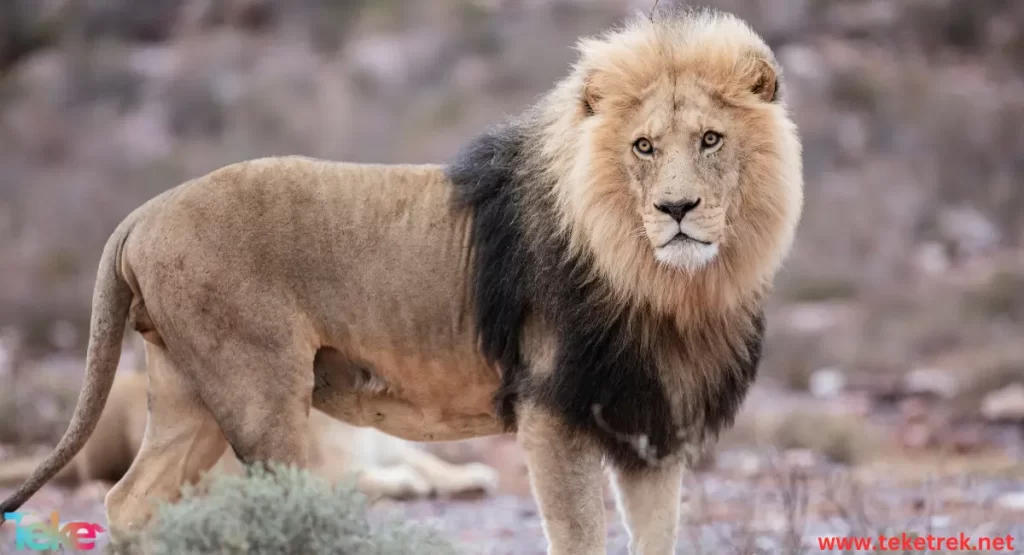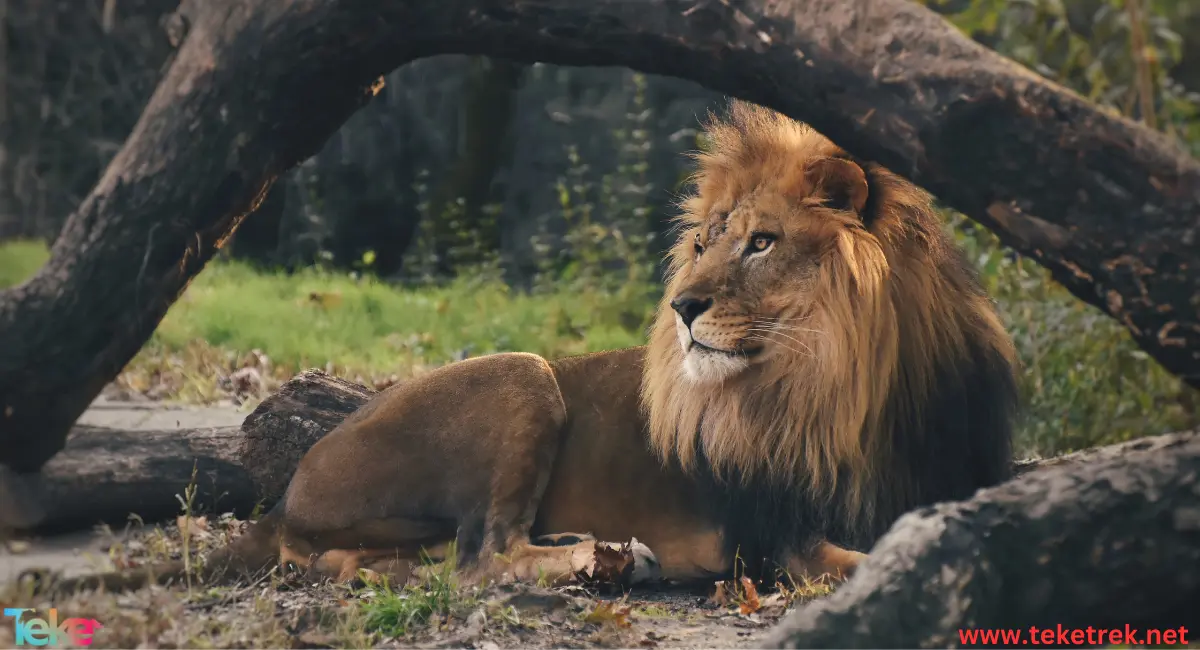The lion is one of the most famous wild animals and the most popular among them. This is in addition to being one of the most predatory animals that live in forests and the bravest among them. Despite being a source of terror for many, it possesses qualities that may astonish us all. Deservedly, it is given the title “King of the Jungle” due to its impressive fitness and strength. In this article from TekeTrek we will discover about it more.
Lion specifications
The lion is a vertebrate massive animal belonging to the family “Felidae” or “cats”, Scientific name: Panthera leo.
- It has immense physical strength, dense fur, a large head, and powerful jaws.
- It is characterized by sharp claws and a roar.
- Known for its ferocity, strength in hunting, and defense of territory, females, and cubs.
- It is considered a symbol of power and strength in many cultures.
- The lion has a large head, short legs, and jaws containing 30 teeth, including canines, each of which is 8 cm long.
- The fur of lions varies in colors, including black, golden, yellowish-brown, and gray.
- The male lion can reach a length of three meters and weigh up to 250 kilograms, while females can reach up to 175 cm and 182 kg.
- Additionally, the lion distinguishes itself from other animals with thick fur on its shoulders, covering its neck, known as the “mane”, which gives it beauty, dignity, and a royal appearance. It also has a long tail that ends in a tuft.
- Lions have two colored eyes that enable them to see in the dark, far better than humans.
- They can survive without water for several days if water is unavailable.
- Lions have a strong sense of hearing, allowing them to hear the sound of prey from about 2 kilometers away.
Naming the lions
- The female lion is often referred to as a “lioness”, and her offspring as a “cub”.
- The lion has many names that describe it, including “al-Leith”, “al-Dargham”, “al-Qaswara”, “al-Saba'”, and “al-Ghadanfar”.
- The prominent title “King of the Jungle” is attributed to its physical qualities that make it powerful.
- Additionally, it is known as the “King of the Jungle” because it possesses unique qualities that other animals do not share.
- The lion does not fear or flee even when certain of its demise.
- Furthermore, it behaves like a king, refusing to eat or drink another animal’s prey unless it is hungry.
- It also does not tolerate the presence of any strange males in its family.
- The lion is characterized by mercy and does not torture its prey.

Lion’s habitat
The lion primarily inhabits Southern Africa and in some regions of Asia such as India and Pakistan.
Lions do not live in rainforests; therefore, they prefer to inhabit grassy plains, savannas, and areas abundant with trees.
Lions can often be found near waterholes, as they use them for surveillance and hunting wild animals.
Reproduction in the lions
- The lion is mammal animal, it has no specific mating season and can reproduce throughout the year.
- In the wild, lions reproduce every two years, while those living in groups mate annually.
- Mating typically begins when the male or female reaches the age of 3-4 years.
- The pregnancy period lasts fourteen months.
- After giving birth, lionesses keep their cubs hidden for the first six weeks.
- A lion cub weighs around 1.5 kilograms at birth.
- Lionesses give birth to varying numbers of cubs, ranging from 1-6.
- Additionally, lion cubs are born completely blind and cannot see until about a month after birth.
Lion’s lifestyle
- The lion prefers to live within a pride.
- The size of pride can reach up to 40 lions.
- Each pride of lions occupies a specific territory for several generations based on the abundance of food and water.
- Lions communicate with each other through visual cues by observing the size of the mane. Additionally, they use vocal communication, particularly through roaring.
- Furthermore, the lion’s mane is considered one of the indicators used to estimate its age. The darker the mane tends to be, the older the lion is likely to be.
Lions food
The lion is considered a carnivorous animal, with meat comprising over 75% of its diet.
- It has a unique dietary system, with most of its prey being herbivores found in grasslands.
- Among its important prey are deer, wildebeest, pigs, buffalo, giraffes, rhinoceroses, rabbits, rodents, and birds.
- A lion can consume up to 35 kilograms of meat in one meal, tearing the food with its teeth before swallowing it without chewing.
- Lions do not eat carrion or dead meat.
The dangers facing the lions
- Illegal hunting is one of the main threats to the lion’s life.
- The developments in life and climate change have led to a decrease and retreat of natural habitats.
- The spread of diseases is also a danger threatening the lion’s life, in addition to the loss of some habitats due to agricultural expansion.
Information you may not know about the lions
- The lion is a lazy animal, sleeping for about 20 hours a day. Most hunting activities occur at night because their eyes easily adapt to darkness.
- One of the most distinctive features of lions is their roar. Lions use roaring to warn enemies and demonstrate their size and strength. It is said that their roar can be heard from a distance of approximately 8 kilometers.
- Additionally, lions are known for their speed and agility. Despite their large size, lions can run at speeds of up to 50 miles per hour for short periods.
- Lions cannot move their eyes. Therefore, the only thing they can do with their eyes is blink.
- In lion prides, females are the leaders in hunting and managing the group.
- Furthermore, the place where lions live is called a den.

Interesting and strange facts
1. Despite being known for their powerful roar, lions also use a quiet sound to communicate within the group.
2. Some believe that lions dislike water, but in reality, lions can have good swimming skills and can easily cross rivers.
3. The rare white lion is known for its ability to endure long periods of hunger and thirst, as it can survive for long periods without food or water.
4. Lions can sometimes climb trees for rest and sleep, which is considered a rare behavior for wild lions.
5. Another lioness can take care of the cubs if their mother dies or separates from them, and this unusual behavior is also found in some other mammals such as elephants.
Lions species
Katanga : This breed weighs up to 280 kg and is characterized by its distinctive dense mane with a sandy or light brown color.
Congo : Spread along the African savannas, it is found in Uganda and the Congo. Weighing up to 190 kg, it is distinguished by its dark and less dense mane.
Transvaal : Considered the sibling of the Katanga Lion, it is rare and notable for its white color.
Barbary : Characterized by a large and dense mane, it lives in the savannas and forests of Africa.
East African : Weighing between 150 and 200 kg, it has a mane darker than other breeds.
Asian : Found in India, this breed is smaller than others and has a reddish mane.
West African : Lives in groups and can reach a length of about 3 meters including its tail.
In conclusion, despite its royal pride, the lion faces significant challenges. Therefore, preserving this magnificent animal is essential to ensure its continuity in nature. This responsibility falls on organizations concerned with wildlife conservation to protect it from extinction and raise awareness about its importance for nature and the environment.
Refrence





